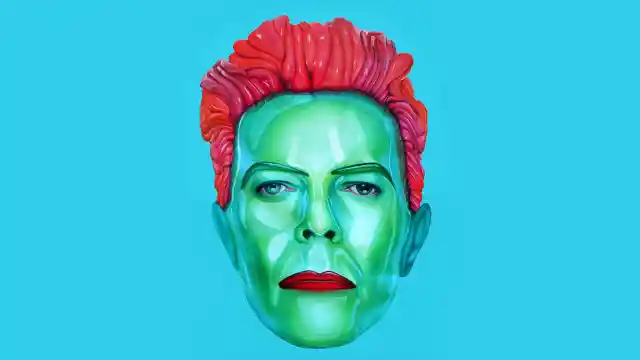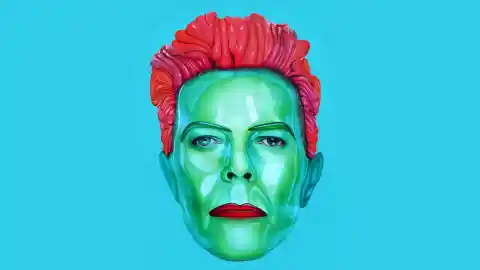

David Bowie has kept us guessing for decades. From Ziggy Stardust to the Thin White Duke, he has reinvented himself more times than Madonna, both musically and physically.
Number Ten: Earthling. David Bowie has always been a leader, so fans were surprised when he jumped on the industrial band wagon with the release of Outside – at least I was. With lackluster sales, he took a stab at techno with the release of Earthling, which also left many of us scratching our heads. However, this album was a very good example of his versatility. Nine Inch Nails frontman Trent Reznor added his production value with a remixed version of “I’m Afraid of America.” With the lead single, “Little Wonder,” Bowie’s experiment garnered him a Grammy nomination, but failed to take home the statue. Reviews, for the most part, were mixed. David Bowie would only record one album in the genre before returning to his crooner style with Outside.
Number Nine: “Heroes”/Low/Lodger. While I’m not a huge fan of the “Berlin Trilogy,” it was an important part of the Bowie catalog. Low was his first in the series of collaborations with ex Roxy Music member Brian Eno. Side one contained some highly accessible tracks as “Sound and Vision” and “Be My Wife,” but also included some highly synthesized tracks as “Speed of Life” and “What in the World.” Side two was much more Kraftwerk influenced with melting soundscapes. “Heroes” followed in the same vein with accessible tracks on the A-side such as the title track and “Beauty and the Beast,” and then B-side, which contained washes of synthetic sounds. While Lodger didn’t house any instrumentals, it still wasn’t geared for mainstream top 40 as tracks such as “DJ,” “Look Back in Anger” and “Boys Keep Swinging” kept the Eno signature in tact. The video for “Boys Keep Swinging” showed Bowie in drag for the second time in his career.
Number Eight: Station to Station. Coming off the widely regarded Young Americans, Bowie kept the party going on Station to Station. Though it was a bit more avant garde with songs such as the title track, which clocked in at a little over 10 minutes and the somewhat experimental “TVCI 15.” To be fair, it did also house the commercial “Golden Years” and the crooning track “Wild Is the Wind.” Though it only contained six tracks, it still gave the buying public nearly hours worth of music.
Number Seven: Hunky Dory. Hunky Dory feels like it should have come after the Ziggy period somehow. It was only Bowie’s fourth release, and though it contained such notable tracks as “Changes” and “Life on Mars?,” one needs to remember that it was released in 1971 when Bowie was still considered a fringe act who was not a commercial success. The album was a nice mix of folk, rock and ballads which danced around topics as celebrities (“Andy Warhol” and “Song for Bob Dylan”), the ambiguous sexual (“Queen Bitch” and “Oh! You Pretty Things”) and cabaret (“Kooks”). Bowie was far ahead of his time and would take awhile for the world to catch up.
Number Six: The Man Who Sold the World. Putting his acoustic and folky sound on hold, Bowie emerged with a solid rock ‘n roll recording on his third offering. The Man Who Sold the World was an in-your-face polarizing recording. It was to be the first time we’d hear Mick Ronson’s slashing guitar riffs which melded perfectly with Bowie’s twisted storybook tales. Though Bowie was shown on a chaise lounge in a dress on the cover, the contents of the album was living proof that he could rock with the best of them. From the opening track, “Width of a Circle,” we knew David Bowie wasn’t screwing around. The title track was covered by Nirvana during their unplugged session, which was further evidence of just how timeless Bowie’s music is.
Number Five: Young Americans. While Bowie provided hints on his Diamond Dogs record, nobody was prepared for such a mature record from this otherwise campy artist. Bowie became enamored with soul music in the mid 1970’s after wowing us with Ziggy and set out to reinvent the genre which he dubbed “Plastic Soul.” The title track gave us a glimpse at what we could expect from the rest of the album as the singer crooned through tracks such as “Fascination,” “Win” and “Right.” He covered the Lennon-penned track “Across the Universe,” and Lennon offered his distinctive voice to the track “Fame.” The Thin White Duke would play with this persona for another album, Station to Station, before his next incarnation.
Number Four: Scary Monsters (and Super Creeps). As MTV broke, some artists were left without any vision with how to create a timeless video whereas David Bowie was fully prepared. Though it was thought of the last album in the Berlin trilogy, comparatively speaking, it resembled none of its predecessors. David Bowie updated us on what “Major Tom” had been up to on “Ashes to Ashes” and made a mockery of the fashion industry on the song “Fashion.” Stylistically, the video for “Ashes to Ashes” showed Bowie’s affection for the theatre. Besides the obvious “hits,” the album lurked in the shadows of the avant garde with tracks such as, “Teenage Wildlife” and “Because You’re Young.” Ashes to Ashes hit the mark on so many levels, it would be hard to dissect it fully.
Number Three: Aladdin Sane. Still sporting the Ziggy persona, Aladdin Sane picks up where Ziggy Stardust left off. The album was chock full of hard rocking tunes as Bowie once again showed how versatile he really was. The title literally means a lad insane as Bowie let us into his mind of strangeness. Still relying on Mick Ronson’s heavy guitar assault, the record hosts some memorable tracks such as “Panic in Detroit,” Cracked Actor,” “Watch that Man,” and a smoking version of the Stones’ classic “Let’s Spend the Night Together.” It also housed some blue-eyed soul such as the title track and “Lady Grinning Soul,” which would be an important development for his next venture.
Number Two: David Bowie Pin Ups
Okay, all you Bowie freaks, yes I realize this was a covers project, but it gave us some timeless classics. The album would prove to be the last collaboration with his touring band “the Spiders from Mars.” The cover features Bowie with super model Twiggy. For the album, Bowie chose some obscure tunes to cover such as the The Pretty Things’ “Rosalyn” and “Don’t Bring Me Down,” the Merseys’ “Sorrow” and the Mojos’ “Everything’s Alright.” He also paid respect to some of his contemporaries such as Them with ” Here Comes the Night” and the Who’s “Anyway, Anyhow, Anywhere.”
Number One: The Rise and Fall of Ziggy Stardust and the Spiders from Mars. Possibly one of Bowie’s greatest achievements, Ziggy tells the story of an androgynous, bisexual, alien rock star. For more on this album, please visit my top ten greatest rock albums of all time. We love you David! R.I.P.